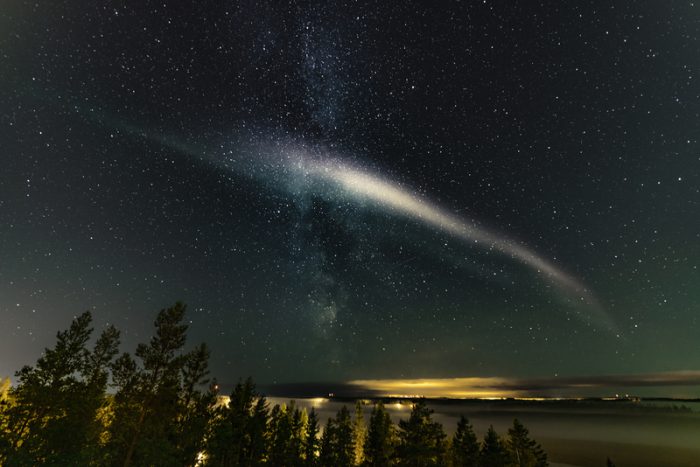The night sky is full of beautiful, breathtaking sights.
Some of these are things that you can predict—like the Perseids meteor shower, which is happening now and every August around this time.
Other events, though, you have to be a bit lucky to see. Being really patient helps, too!
One of these types of sights is STEVE. No, we're not talking about some guy flying across the sky in a giant balloon. We're talking about 'Strong ThErmal Velocity Enhancement', an especially rare and strange type of aurora that scientists are still trying to figure out.
The phenomenon appears as a long purplish band across the sky. This strip is often accompanied by small streaks of green around the edges. What to know what we mean? Of course you do!
Hi, STEVE!
Recently, a Canadian named Alan Dyer was out all night taking pictures. Alan is no ordinary photographer. This Albertan is also an author and a specialist in taking photos of the night sky. And boy, oh boy was he ever out on the right night to capture something spectacular!
As the night of August 7 became the morning of August 8, Alan saw an amazing version of the STEVE aurora. And he gathered his photos of the event into a video slideshow that you can check out right here! (As an added bonus, you'll also see quite a few of those Perseids meteors flying across the sky—what an action-packed video!)
A Showing of STEVE from Alan Dyer on Vimeo.
That is absolutely beautiful, right? So ... what is it?
What is an aurora?
Some truly spectacular northern lights as seen over Norway in 2016. (Getty Embed)
It's not much help to say that STEVE is a special type of aurora if you're not sure what an aurora is in the first place. So let's start there!
The auroras are light shows high up in Earth's atmosphere that happens near the poles (the top and bottom of the planet). Earth is not the only planet with auroras. They have been seen over Jupiter, for example.
On Earth, there are two main types of auroras. The aurora borealis, or northern lights, happen around the North Pole and are seen in countries like Canada, Norway, Sweden, and Russia. The aurora australis, or southern lights, happen in the South Pole and are mostly seen in Antarctica. In both cases, they appear as flowing ribbons of glowing light. They can be all sorts of colours, including blue, red, and purple, but they are most commonly a shade of green.
They are caused by solar wind—streams of high-speed, electrically charged particles that are ejected by the Sun—that collide with the atmosphere. As these waves of solar wind hit the atmosphere, the collisions create spectacular light shows for us to see!
Why is STEVE special?
So if we already understand auroras, then why is STEVE different and mysterious to science?
For one, STEVE happens much farther south than typical auroras. And it wasn't even discovered until 2017, when it was recorded for the first time over parts of Canada. (Here is the post that we wrote about it from back then.)
It also appears lower in the atmosphere than a normal aurora. The area where it happens is actually called the 'subauroral zone', meaning 'beneath the auroras'. In other words, it is an area where this stuff normally does not happen.
Because it happens lower in the atmosphere, scientists do not think that it is just caused by solar wind particles. Studies suggest that STEVE is a column of super-heated air that is around 3,000 degrees Celsius (5,500 F) and that moves at a speed that is around 500 times faster than the air around it. It's like we're seeing a rocket of air blast through the sky!
But what is the connection to regular auroras? Well, so far, scientists have noticed that it happens when there are strong solar wind and storms hitting the Earth. (There was one on August 7 when STEVE was last seen.) So there definitely seems to be a connection between the forces that create the northern lights and STEVE. But what that connection is exactly still has to be figured out.
In the mean time, here is a NASA video that will at least help to unpack some of what brings STEVE to life.
 A previous image of a STEVE aurora, as seen over Sweden. A new one was seen in southern Alberta last week. (ID 162576517 © Alexandrepatchine | Dreamstime.com)
A previous image of a STEVE aurora, as seen over Sweden. A new one was seen in southern Alberta last week. (ID 162576517 © Alexandrepatchine | Dreamstime.com)









